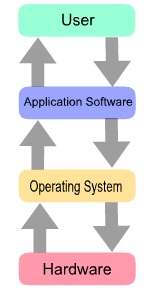What is Software: Computer software, or only software, is a kind of program that enable a user to perform some specific task or used to operate a computer. It directs all the peripheral devices on the computer system – what to do and how to perform a task. PC Software plays the role of mediator between the user and computer hardware. Without software, a user can’t perform any task on a digital computer.
A computer system can be divided into three components: the hardware, the software, and the users. Software can be further divide into mainly two parts: Application software and System Software. Bare use of hardware is not easy, so to make it easy, software created.
We’ll be covering the following topics in this tutorial:
Type of Software
The software has mainly divided into two categories: Application software and System software.

Application Software
Applications software also called end-user programs or merely an application. It resides above system software. The end-user uses applications software for a specific purpose. It programmed for simple as well as complex tasks. It either be installed or access online. It can be a single program or a group of small programs that referred to as an application suite.
Application software can be used by the user to complete specific tasks, such as creating word processors documents, spreadsheets, presentations, graphics, CAD/CAM, sending the email, etc.
System Software
System Software (the type of computer program) provides a platform to run a computer’s hardware and computer application to utilize system resources and solve their computation problem. It is written in a low-level language, like assembly language, so it can easily interact with hardware with the primary level. It controls the working of peripheral devices. System software act as a scheduler for the execution of the processes and arrange the sequence according to their priority and I/O devices requirement and creation of the process. The best-known example of system software is the operating system (OS). It responsible for manages all the other programs on a computer.
The operating system creates an interface between user and hardware and also in application software and hardware. Examples of software are Windows 7, Windows XP, and Windows 10.
Generally, the user does not interact with the System Software directly. The user interacts with the GUI created by System Software. Through this, GUI user interacts with applications installed in the system.
Other examples of system software and what each does
Utility: Utility Program-Usually utility software installed during the installation of OS. Utility program helps in analyze, configure, secure, optimize and maintain the system. List of utility program-Disk checker, disk cleaner, disk derangement, disk space analyzer, disk backup etc.
Open Source: Open source software is available with source code. Software is an intellectual or collaborative effort of programmers to improve the quality of software. Usually, the software is available with a license for those programmers who want to change the functionality according to their choice. Examples are- Apache, Tomcat, Ubuntu, MySQL (database), and Firefox etc.
Public domain software: Public domain software is free to use the software in the public domain. The software can be modified, distributed or sold without any attribution. It is copyright, unpatented software, where Freeware and Open-Source software have copyright.
 Dinesh Thakur holds an B.C.A, MCDBA, MCSD certifications. Dinesh authors the hugely popular
Dinesh Thakur holds an B.C.A, MCDBA, MCSD certifications. Dinesh authors the hugely popular